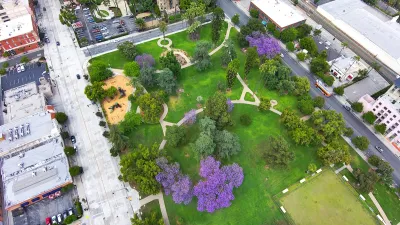Are parks landscapes or infrastructures -- or can they be both? This question is broached in this wide-reaching interview on the role of parks in cities with landscape architect Gerdo Aquino.
Aquino, president and principal of SWA Los Angeles studio, discusses the fundamental question of what a park is and what it should be.
"Nam- In terms of maximizing these sorts of multi-use, multi-programmed, multi-functionality, infrastructures, I was talking with a friend the other day, and he was saying, "Why does it have to always be a park?". I responded to my friend that given the generally low per-capita ratio in many urban areas, off access to green, open space, "why not a park?". What would you have said to my friend?
Gerdo- I would have probably posed another question to him back, "what is a park?", and when asked this question, many people don't have a quick response. They think it is a) a trick question or b) that I am crazy. At USC, the landscape architecture and architecture students are all asking ourselves that question. What is a park? Does a park have to be green? Is a park, Central Park in NYC? You can look at Olympic Sculpture Park in Seattle, and it's basically a ramp. Parks have started to become this ambiguous thing, a cure-all for what ails the city. I think it is a bit more than that. I think architects, landscape architects and planners are going to have to figure out what are the issues. And you brought up the per-capita issue of access to open space. Here in Los Angles, there is such a place. I think it has the lowest per-capita ratio in all of California. Just East of Hollywood."
FULL STORY: What is a Park - Landscape or Infrastructure

Alabama: Trump Terminates Settlements for Black Communities Harmed By Raw Sewage
Trump deemed the landmark civil rights agreement “illegal DEI and environmental justice policy.”

Planetizen Federal Action Tracker
A weekly monitor of how Trump’s orders and actions are impacting planners and planning in America.

The 120 Year Old Tiny Home Villages That Sheltered San Francisco’s Earthquake Refugees
More than a century ago, San Francisco mobilized to house thousands of residents displaced by the 1906 earthquake. Could their strategy offer a model for the present?

Indy Neighborhood Group Builds Temporary Multi-Use Path
Community members, aided in part by funding from the city, repurposed a vehicle lane to create a protected bike and pedestrian path for the summer season.

Congestion Pricing Drops Holland Tunnel Delays by 65 Percent
New York City’s contentious tolling program has yielded improved traffic and roughly $100 million in revenue for the MTA.

In Both Crashes and Crime, Public Transportation is Far Safer than Driving
Contrary to popular assumptions, public transportation has far lower crash and crime rates than automobile travel. For safer communities, improve and encourage transit travel.
Urban Design for Planners 1: Software Tools
This six-course series explores essential urban design concepts using open source software and equips planners with the tools they need to participate fully in the urban design process.
Planning for Universal Design
Learn the tools for implementing Universal Design in planning regulations.
Clanton & Associates, Inc.
Jessamine County Fiscal Court
Institute for Housing and Urban Development Studies (IHS)
City of Grandview
Harvard GSD Executive Education
Toledo-Lucas County Plan Commissions
Salt Lake City
NYU Wagner Graduate School of Public Service





























